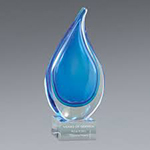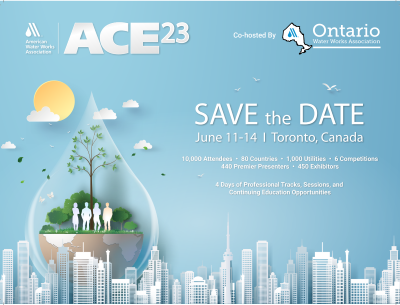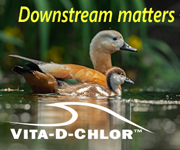 |
||||||||||||||||||||||||||||
| Subscribe | Past Issues | www.cwwa.ca | Water Source Magazine | ||||||||||||||||||||||||||||
|
CWWA News
It’s never really slow in Ottawa, but lately, we have been really busy responding to national issues and federal programs. CWWA is collaborating with the Water Canada Summit to bring you our first in person Window on Ottawa since 2019! This collaboration means we’ll be bringing you an event that features not only the federal updates and panel discussions you expect from the Window on Ottawa, but also a broader look at water issues across Canada, with a holistic approach to water resource management.
Federal Initiatives
ACE, where the water community comes together to learn, connect, and be inspired to solve global water challenges. Health Canada has published final guidelines for Boron in drinking water. The guidelines establish a maximum acceptable concentration (MAC) of 5 mg/L (5 000 μg/L) for total boron in drinking water based on treatment achievability. Boron enters the environment from natural sources, such as seawater spray and the weathering of rocks and soils, as well as from human activities. The main source for Canadians’ exposure to boron is food, although consumer products can also contribute significantly to exposure. Exposure through drinking water can contribute up to 16% of total dietary boron exposure. In most Canadian drinking water supplies, boron is below 0.1 mg/L. In water, boron exists primarily as boric acid and borate. Adverse effects to the male reproductive system following ingestion of high levels of boron have consistently been observed during studies in animals. The health-based value (HBV) is derived using a conservative approach, intended to be protective against potential reproductive effects. Objective for Canadian Drinking Water Quality: Per- and Polyfluorinated Substances in Drinking Water
To reduce exposure from drinking water, an objective of 30 nanograms (ng) per litre (L) is proposed for the sum of total per- and polyfluoroalkyl substances (PFAS) detected in drinking water. Access the consultation document CWWA’s Drinking Water Quality Committee is reviewing the proposed objectives and will be submitting comments, which we will share with our members once submitted. The Committee also prepared a Fact Sheet on PFAS/PFOS substances in drinking water. Health Canada hosted a webinar to provide an overview of the proposed objective and the science used to develop it. You can access the slides and a recording online. On-going direct engagement re: government plans to develop a new law to support safe, reliable drinking water and wastewater infrastructure in First Nations communities. A key objective of Office of Energy Efficiency (OEE) of Natural Resources Canada (NRCan) is to improve energy efficiency. Reducing water consumption drives energy efficiency and cost savings by decreasing energy consumption from the collection, treatment and delivery of water and wastewater upstream and downstream of a home. NRCan is seeking to develop an up-to-date estimate of the energy intensity for the provision of water and wastewater services, as well as an up-to-date estimate of the average variable water and wastewater service rates in Canada’s residential sector.
The CTV network’s W5 recently aired an investigative piece on asbestos-cement pipe. The episode is titled “Something in the Water” and is being promoted as an exposé of a serious threat to community health. You can watch the full episode on the W5 youtube channel
We’re excited to share updates on the NWWC 2023! The Call for Presentations closes at the end of March and our Technical Committees will be busy reviewing the submissions and building the program. We had a great response to the Call for Presentations, and all our Committees are also working on building specialty sessions, to make sure we’re addressing the most critical issues for the industry and that we have a program that represents all aspects of water and wastewater. Member News
As a community of water professionals, AWWA and its members share EPA’s desire to keep harmful levels of PFAS out of the nation’s drinking water. We support setting national drinking water standards for PFAS that protect all consumers, including the most sensitive populations, using the best available science. We stand for transparency, and support requirements for utilities to actively share PFAS monitoring results and other water quality information with consumers. We support sound scientific process to create regulations in which the public health benefits outweigh the costs.
The number of weather-related natural catastrophes in Canada has increased in the last few decades. Damages caused by floods and rainstorms comprise a significant portion of the financial costs associated with these events. There are several factors contributing to this trend, including a high number of properties located in flood-prone areas, loss of permeable surfaces due to urbanization, aging infrastructure, and changes in the intensity, frequency, or duration of precipitations due to climate change. University of Victoria’s POLIS Water Sustainability Project joins watershed champions and groups across B.C. in celebrating yesterday's announcement of a $100 million Watershed Security Fund and the release of the Watershed Security Strategy Intentions Paper.
The Berkeley Springs International Water Tasting, the world’s most prestigious, gave out awards to waters from four continents. Five continents had waters among the nearly 100 entered. The municipal water category saw three former gold medalists in the top five. Gold went to Clearbrook, BC, Canada. Silver medal was won by first time entry South Muskoka, ON, Canada. Bronze medal was won by St. Paris, OH, making them the best in the United States. There was a tie for fourth place, between former gold medalist Emporia, KS and first time entry Miryang-si, Gyeongsangnam-do, Republic of Korea. In fifth place, just one single point behind, was former gold medalist Eldorado Springs, CO. ACE, where the water community comes together to learn, connect, and be inspired to solve global water challenges.
Provincial News
Snippings & Clippings
Bloomberg Law The first-ever national drinking water limits for PFAS the EPA proposed Tuesday are raising concerns about the costs to utilities and ratepayers, questions from industry about the science the agency used, and predictions of more litigation over the health effects of the chemicals. ES&E Magazine After measuring and analyzing emissions from 63 U.S. municipal wastewater treatment plants, two new studies by researchers at Princeton University show that the process used to quantify methane emissions may be substantially underestimating the extent of the methane released. ES&E Magazine As a “sign of caution,” Québec has issued a temporary moratorium on biosolids imports from the U.S., as it works to establish control mechanisms and thresholds for per- and polyfluoroalkyl substances, better known as PFAS. AP News The Environmental Protection Agency on Tuesday proposed the first federal limits on harmful “forever chemicals” in drinking water, a long-awaited protection the agency said will save thousands of lives and prevent serious illnesses, including cancer. The Hill The Environmental Protection Agency (EPA) will require states to evaluate cybersecurity as part of their checks on public drinking water systems. The agency said Friday that many such systems haven’t taken basic steps to ensure their security, even as cyberattacks are becoming more frequent. Water Canada The City of North Bay has proactively undertaken a study to evaluate options for enhancing its water treatment process to meet potential future regulatory changes related to per- and polyfluoroalkylated substances (PFAS). Water Canada In recent issues, Water Canada has outlined many of the challenges operators face keeping systems up and running, often under difficult conditions and for pay barely exceeding minimum wage. Systems frequently operate on threadbare budgets, and some communities have endured boil water advisories for decades as band councils juggle multiple, equally urgent priorities. |
||||||||||||||||||||||||||||
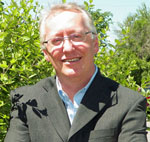
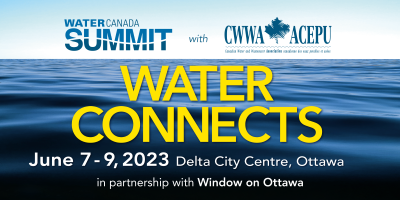

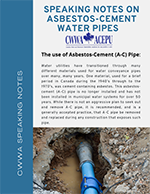
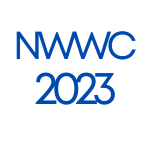
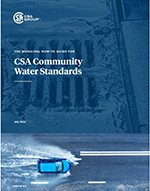
.png)
